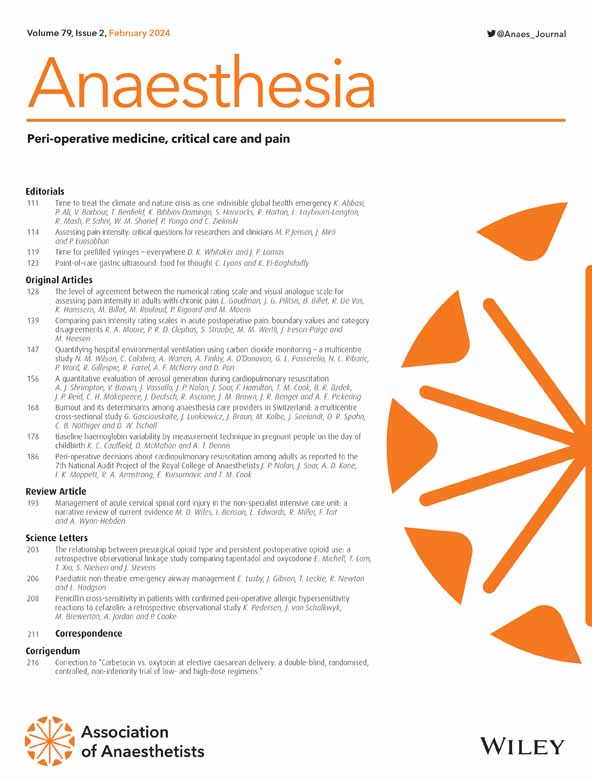The combination of interpectoral plane and superficial serratus anterior plane blocks for the prevention of persistent pain after total mastectomy: a triple-blinded, randomised, placebo-controlled trial.
IF 6.9
1区 医学
Q1 ANESTHESIOLOGY
引用次数: 0
Abstract
INTRODUCTION Chronic post-mastectomy pain may be preventable with regional analgesia. Ultrasound-guided fascial plane blocks are accepted alternatives to paravertebral block for patients undergoing mastectomy. While fascial plane blocks may be used individually, combining them may be more effective. This study tested the hypothesis that combining interpectoral plane and superficial serratus anterior plane blocks would reduce the incidence of chronic post-mastectomy pain compared with the superficial serratus anterior plane block alone. METHODS We enrolled adult women scheduled to undergo total mastectomy with or without lymph node dissection. The intervention group received both interpectoral plane and superficial serratus anterior plane blocks with 0.375% ropivacaine pre-operatively. The control group received saline as the interpectoral plane injection and a superficial serratus anterior plane block with 0.375% ropivacaine. The primary outcome was the incidence of any pain at rest at 6 months postoperatively. Secondary outcomes included pain intensity and location at rest and with movement at 2 h, 24 h, 1 month, 3 months and 6 months postoperatively. RESULTS In total, 100 patients were enrolled and allocated randomly. For the primary outcome by intention-to-treat analysis, nine (18%) patients allocated to the intervention group reported post-mastectomy pain at rest at 6 months postoperatively compared with 19 (38%) allocated to the control group (OR 0.36, 95%CI 0.13-0.98, p = 0.044). Per-protocol analysis, not including three cases of protocol violation, showed no difference between groups for the same comparison. Pain scores were very low in both groups at 6 months postoperatively, and no patient was still using analgesics. There were no differences in acute pain scores or other secondary outcomes. DISCUSSION The addition of interpectoral plane block to superficial serratus anterior plane block may reduce the incidence of rest pain at 6 months post-mastectomy. Other factors influence chronic postsurgical pain development and deserve further study.胸间平面和前锯肌浅平面联合阻滞预防全乳切除术后持续疼痛:一项三盲、随机、安慰剂对照试验。
乳房切除术后慢性疼痛可以通过局部镇痛来预防。超声引导筋膜平面阻滞是接受替代椎旁阻滞患者接受乳房切除术。虽然筋膜平面阻滞可以单独使用,但将它们结合使用可能更有效。本研究验证了胸间平面联合前锯浅肌平面阻滞比单独前锯浅肌平面阻滞能降低乳房切除术后慢性疼痛发生率的假设。方法:我们招募了计划行全乳切除术伴或不伴淋巴结清扫的成年女性。干预组术前应用0.375%罗哌卡因进行胸间平面和前锯肌浅平面阻滞。对照组采用生理盐水作胸间平面注射,0.375%罗哌卡因在前锯肌浅表平面阻滞。主要结局是术后6个月休息时疼痛的发生率。次要结果包括术后2小时、24小时、1个月、3个月和6个月休息和活动时的疼痛强度和位置。结果共纳入100例患者,随机分配。意向治疗分析的主要结局是,干预组9例(18%)患者报告术后6个月乳房切除术后休息疼痛,对照组19例(38%)(OR 0.36, 95%CI 0.13-0.98, p = 0.044)。每协议分析,不包括三个违反协议的情况,在相同的比较中,各组之间没有差异。两组患者术后6个月疼痛评分均很低,无患者仍在使用镇痛药。急性疼痛评分和其他次要结果没有差异。胸间平面阻滞加前锯肌浅平面阻滞可减少乳房切除术后6个月静息痛的发生率。其他影响术后慢性疼痛发展的因素值得进一步研究。
本文章由计算机程序翻译,如有差异,请以英文原文为准。
求助全文
约1分钟内获得全文
求助全文
来源期刊

Anaesthesia
医学-麻醉学
CiteScore
21.20
自引率
9.30%
发文量
300
审稿时长
6 months
期刊介绍:
The official journal of the Association of Anaesthetists is Anaesthesia. It is a comprehensive international publication that covers a wide range of topics. The journal focuses on general and regional anaesthesia, as well as intensive care and pain therapy. It includes original articles that have undergone peer review, covering all aspects of these fields, including research on equipment.
 求助内容:
求助内容: 应助结果提醒方式:
应助结果提醒方式:


